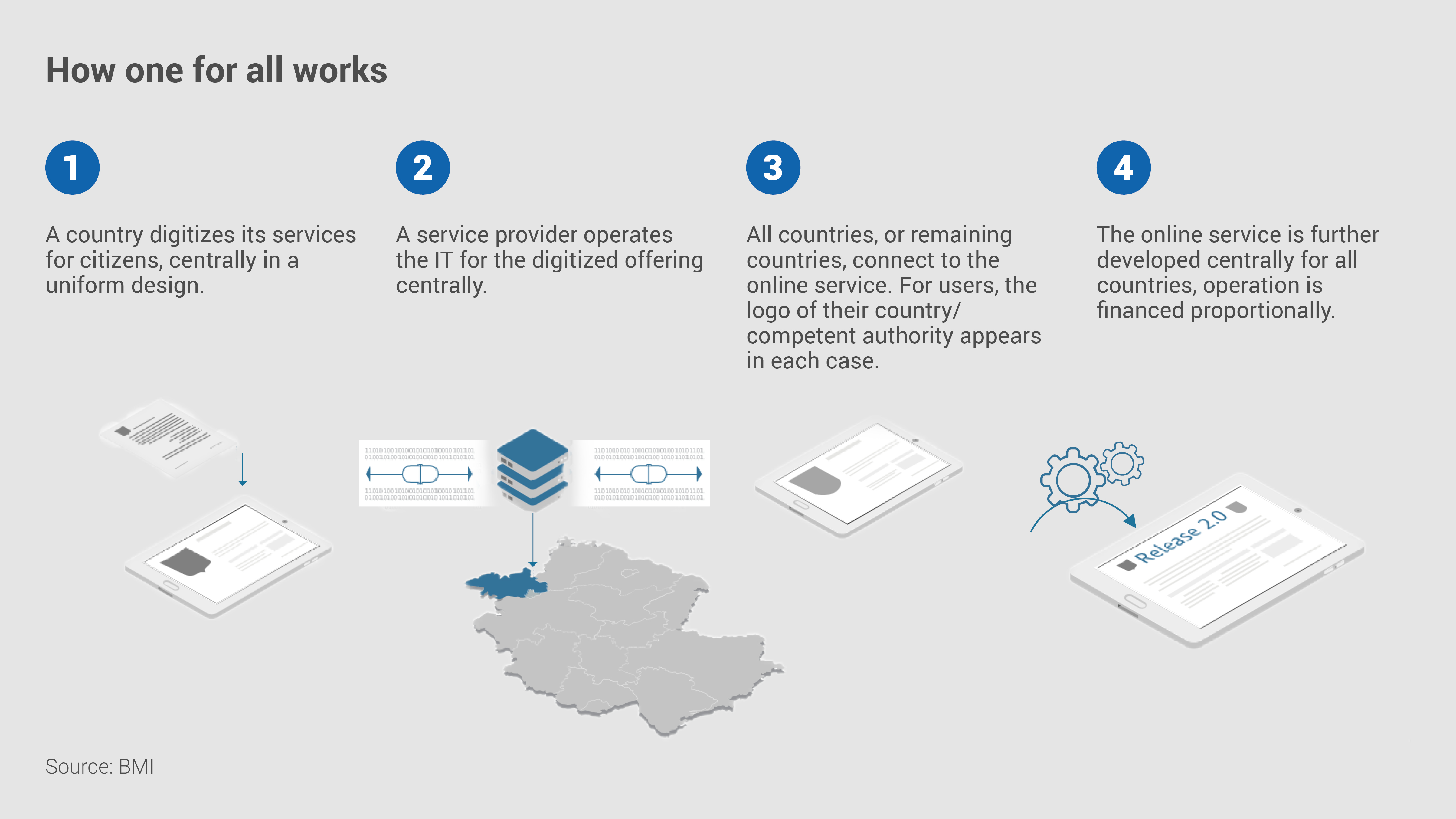The Act to Improve Online Access to Administrative Services (Online Access Act, OZG) obliges the federal government, the states and local authorities to also offer all administrative services digitally by the end of 2022 and to combine them into a network via portals. The law already came into force in 2017, but its implementation is only slowly picking up speed. This is now happening against the backdrop that the time horizon specified in the law is drawing ever closer with increasing urgency.
In the context of the OZG, the past few years have been used extensively to develop initial prototypes of digital administrative services within the framework of "digital labs" with the help of user journeys and with the involvement of individual federal states. In addition, the requirements for the uniform operation of OZG services were successively created in the federal states. These include, for example, the development of data exchange infrastructures, service accounts that are uniform across the federal states, or technical search engines that can find the relevant authorities and pass on their addresses (the OZG Yellow Pages).
Now that most of these foundations of the so-called basic components have been laid, however, there is still often a lack of actual implementation of the OZG, which is also apparent to citizens: the provision of digitized application procedures.
The one-for-all (EfA) principle is intended to accelerate precisely this last step. Some of the 575 OZG service bundles, which bundle the individual administrative procedures to be digitized, have again been combined into 14 OZG topic areas. Each of these is implemented under the leadership of a federal state with a federal department, whereby a high degree of standardizability and thus subsequent use by other federal states is planned. As soon as a digitized administrative service is available, it can and should be reused, with individual components being adapted to the respective needs of the reusing states.

In the meantime, the challenges of the EfA principle have become apparent
Overall, the EfA principle makes sense in order to take the massive effort of digitizing applications at least partially off the shoulders of the individual municipalities and states and to ensure a high degree of reusability. Against the backdrop of limited time - there are only about one and a half years left to digitize several hundred administrative services - it is an important building block for achieving the OZG goals. However, the EfA principle faces a number of challenges that can best be divided into the dimensions of organizational, technical, legal and financial.
Organizational: The necessary roles, bodies and processes must be established. This relates in particular to cross-country exchange, for example in the form of "post-utilization steering groups" but also to the possibilities for continuous improvement and further development of the EfA solution, into which the interests and wishes of the post-utilizing countries must also be incorporated.
Technical: The projects must adhere to a minimum set of common standards so that connection and operation can run smoothly. These are partly subject area-specific, such as the use of XÖV variants, or relate to data transfer, such as XTA and OSCI.
Legal: Suitable legal models must be established for the cross-border provision of services. These must take into account the special features of public procurement law, but on the other hand must be flexible and particularly practical in terms of the EfA principle.
Financial: Appropriate approaches must be found for the distribution of costs between the players involved. A number of models have already been proposed by the IT Planning Council, but each of these must be discussed in the design of an EfA solution in order to lead to a fair distribution of costs. There is a close link here to the legal requirements.
Expert opinion: EfA solutions will not fall from the sky
When the EfA principle is viewed against this complex background and the many unresolved aspects in the individual dimensions are included, one thing becomes clear: the states and municipalities must not rely on the OZG becoming a no-brainer via EfA.
Based on our expertise from ongoing OZG implementation projects, we see the danger that authorities will continue to wait too passively and reactively in the hope that simple follow-up options will be offered as soon as possible from the respective countries in charge of the subject areas. It is clear, however, that to date there are hardly any solutions that can be reused from a technical point of view. Even if these can be offered, many points still need to be clarified. It is often uncertain whether the solutions can even cover the respective legal and functional requirements or can be integrated into the existing procedural landscape. Therefore, it is a long way until an EfA solution can really go "live" across the board in the downstream countries.
Critical aspects are summarized in the following four steps. As a rule, these must be completed by downstream countries before an EfA solution can be successfully downstreamed.
EfA: the steps to subsequent use
- Expert evaluation: Countries interested in reuse must assess from an expert perspective whether reuse is possible and reasonable. This can be done quickly for federally regulated topics, but is anything but trivial in areas governed by state-specific rights and regulations.
- Technical evaluation: the downstream country must ensure that all technical requirements are covered by an EfA solution. It is true that most architectural and infrastructural issues should be clarified by the creating country during the initial implementation. However, the downstream country must verify that the interfaces into the affected state and local authorities are functional and meaningful. This is particularly important because the administrative structure in the individual federal states differs, sometimes massively. For example, due to the very high number of cities and municipalities, states such as North Rhine-Westphalia sometimes have to consider several hundred authorities for a single OZG service, whereas other states have set up their administration differently and only have to consider a handful of authorities. Also, the coverage and use of administrative software, which is key to overall digital application processing, is highly heterogeneous across the states and even authorities - but must be included in a technical evaluation.
- Financial: Particularly in the subject areas in which authorities already use extensive IT support and operate so-called specialized procedures, there are already sometimes far-reaching IT solutions in use which can compete with EfA solutions. Here, it must be ensured that the EfA solution represents the most economical solution for the municipalities and authorities, even taking into account its benefits and functionalities, in order to ensure broad acceptance.
- Legal: At the present time, many legal conditions have not yet been clarified. This is expected to change, especially with intensive use of the fit store. Countries interested in the subsequent use of EfA solutions should cooperate with the creating country in this regard, so that their interests and wishes can also be taken into account in the creation of the necessary service descriptions. They can also only influence pricing or cost allocation in advance, which can be carried out according to very different interests.
From our technical expert point of view, it is enormously important that the technical sides in the states and those responsible in the ministries and authorities do not wait for a simple and ready-made solution for their OZG services to be presented to them via the EfA principle by the end of next year, which they will then roll out quickly by the deadline. These solutions will very likely be unavailable or unusable for their own purposes, leading to enormous pressure and chaos by the end of the OZG implementation period. Instead, the relevant agencies should already be engaged in extensive planning for their OZG services and should bring their own requirements into the process. For example, attentive monitoring of the projects in the lead country should be carried out by the countries interested in subsequent use. Within this framework, the above-mentioned steps for subsequent use can already be implemented in advance and a well-founded decision can be made about subsequent use or partial subsequent use of an EfA solution or the possibly necessary in-house production of the OZG service.







